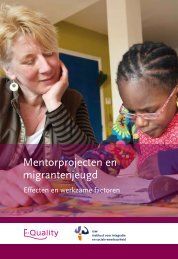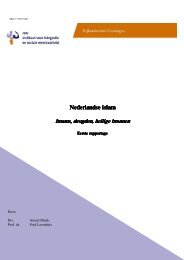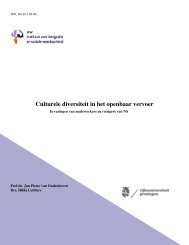Werken aan sociaal weerbare wijken - Instituut ISW
Werken aan sociaal weerbare wijken - Instituut ISW
Werken aan sociaal weerbare wijken - Instituut ISW
You also want an ePaper? Increase the reach of your titles
YUMPU automatically turns print PDFs into web optimized ePapers that Google loves.
Centrum voor Criminaliteitspreventie en Veiligheid (2008). Handboek<br />
Buurtbemiddeling. Geraadpleegd:<br />
http://www.hetccv.nl/binaries/content/assets/ccv/webwinkel/brochurebuurtbemiddeling-2009.pdf<br />
Chen, H.T. (1990). Theory driven evaluations. London: Sage.<br />
Coles, E. & Buckle, P. (2004). Developing community resilience as a foundation for effective<br />
disaster recovery. In: The Australian Journal of Emergency Management, 19, 5-6.<br />
Cook, S. (1978). Interpersonal and attitudinal outcomes in cooperating enterracial groups.<br />
Journal of Research and Development in Education, 12, 97-113.<br />
Cotterill, L. (2002). Developing capacity for theory-based evaluation. In: L. Bauld and K.<br />
Judge (Eds.) Learning from Health Action Zones. Chichester: Aeneas Press.<br />
Crawford, A. (1998), Crime prevention & community safety. Politics, policies & practices. Harlow:<br />
Longman.<br />
Crisp, R.J., Stone, C.H., & Hall, N.R. (2006). Recategorization and subgroup<br />
identification: Predicting and preventing threats from common ingroups. Personality<br />
and Social Psychology Bulletin, 32, 203-243.<br />
Dagevos, J. (1996). Sociale netwerken en hun functionaliteit. In: J. Veenman (Eds.), Keren de<br />
kansen? De tweede generatie allochtonen in Nederland (pp. 81-101). Assen: Van<br />
Gorcum.<br />
Dagevos, J. (2001). Perspectief op integratie. Over de <strong>sociaal</strong>-culturele en structurele<br />
integratie van etnische minderheden in Nederland. Den Haag: Wetenschappelijke<br />
Raad voor het Regeringsbeleid.<br />
Davies, A. (2001). What silence knows. Planning, public participation and environmental<br />
values, Environmental Values, 10, 77-102.<br />
De Kam, G. & Needham, B. (2003). Een hele opgave. Over sociale cohesie als motief bij<br />
stedelijke herstructurering. Nijmegen: DGW/NETHUR.<br />
Dirven, J., Rotmans, J. & Verkaik, A. (2002). Samenleving in transitie: een vernieuwend<br />
gezichtspunt. Den Haag: Innovatienetwerk Agrocluster en Groene Ruimte.<br />
Dovidio, J. F., Gaertner, S.L., & Saguy, T. (2007). Another view of ‘we’: Majority<br />
and minority group perspectives on a common ingroup identity. European review of<br />
social psychology, 18, 296-330.<br />
Dovidio, J. F., Gaertner, S. L., & Saguy, T. (2009). Commonality and the complexity of ‘we’:<br />
Social attitudes and social change. Personality and Social Psychology Review, 13, 3-<br />
20.<br />
Duyvendak, J.W. & Hurenkamp, M. (red) (2004). Kiezen voor de kudde. Lichte<br />
gemeenschappen en de nieuwe meerderheid. Amsterdam: Uitgeverij Van Gennep.<br />
Edelenbos, J., Klaassen, H.L. & Schaap, L. (2005). Burgerparticipatie zonder<br />
verantwoordelijkheid. Rotterdam: Faculteit Sociale Wetenschappen – Erasmus<br />
Universiteit rotterdam.<br />
Edelenbos, J., Teisman, G.R. & Reuding, M. (2001). Interactieve beleidsvorming als<br />
sturingsopgave. Den Haag: InnovatieNetwerk Groene Ruimte en Agrocluster.<br />
Ellen, I.G. & Turner, M.A. (1997). Does neighbourhood matter? Assessing recent evidence.<br />
Housing Policy Debate, 8, 4, 833-866.<br />
Ellis, H. (2000). Planning and public empowerment: third party rights in development control.<br />
Planning Theory & Practice, 1, 203-217.<br />
178 | <strong>Werken</strong> <strong>aan</strong> <strong>sociaal</strong> <strong>weerbare</strong> <strong>wijken</strong>






